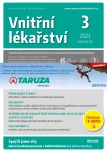Multimorbidity in nephrotic syndrome
Authors:
Vladimír Teplan 1,2
Authors‘ workplace:
Interní a kardiologická klinika Fakultní nemocnice Ostrava a Lékařská fakulta Ostravské univerzity, Ostrava
1; Subkatedra nefrologie, Institut postgraduálního vzdělávání ve zdravotnictví, Praha
2
Published in:
Vnitř Lék 2023; 69(3): 156-165
Category:
Main Topic
doi:
https://doi.org/10.36290/vnl.2023.028
Overview
Nephrotic syndrome (NS) is characterized by high proteinuria (over 3,5g/24 hrs), hypalbuminaemia, general edemas and hypercoagulation. Beside of primary glomerulonephritides this is found in secundary glomerulopaties eg. diabetes, systemic inflammatory diseases, oncology, damage by drugs and poisoning, by alergy, serious infections and in children from hereditary reasons. The most frequent reason for NS in adults patiens is diabetes and diabetes with nephropathy represents almost 40% of dialysed patiens. From this point of view, there is great interest focusing on gliflozins (SGLT2 inhibitors) with positive nephroprotecive effect. It leads do increasing of glycosuria with concomitant natriuresis and osmotic diuresis. The effect is proportional to glomerulal filtration, but the effect on natriuresis stay in all stages of renal insufficiency.
Keywords:
diabetes – gliflozins – nephrotic syndrome – primary and secundary glomeruolopaties
Sources
1. Teplan V, et al. Praktická nefrologie, Grada Publishing, Praha. 2006.
2. Wang CS,Greenbaum LA. Nephrotic syndrome.Pediatr Clin North Am. 2019;66(1):73-85.
3. Downie ML, Gallibois C,Parekh RS, Noone DG.Nephrotic syndrome in intants and childre: pathyophysiology and management.Paediatr Int Child Health. 2017;37(4):248-258.
4. Václavík J. Dyslipidemia and hypertension – what to worry about more? Vnitř Lék. Spring 2018;(4):395-401.
5. Politano SA,Colbert GB,Hamiduzzaman N. Nephrotic syndrome. Prim Care. 2020;47(4):597-613.
6. Noone DG, Iijima K, Parekh R. Idiopathic nephrotic syndrome in children. Lancet. 2018;392(10):61-74.
7. Saleem MA. Molecular stratification of idiopathic nephrotic syndrome. Nat Rev Nephrol. 2019;15(12):750-765.
8. Kodnesr C. Diagnosis and management of nephrotic syndrome in adults. AmFamPhysician. 2016;93(6):479-485.
9. Siddall EC, Radhakrishan J. The pathophysiology of edema formation in the nephrotic syndrome. Kidney Int. 2012;82(6):635-642.
10. Teplan V. Nefrotický syndrom, in V. Teplan a kol. Metabolismus a ledviny Grada Avicenum Praha 2000:249-255.
11. Iijima K, Sako M, Nozu P. Rituximab for nephrotic syndrome in childre. Clin Exp Nephrol. 20187;21(2):193-202.
12. Meena J, Bagga A. Current perspectives in management of edema in nephrotic syndrome. Indian J Pediatr. 2022;87(8):633-640.
13. Vaziri ND. Disorders of lipid metabolism in nephrotic syndrome: mechamisms and consequences. Kidney Int. 2016;90(1):41-52.
14. Seigneux S, Martin PY. Management of patients with nephrotic syndrome. Swiss Med Wkly. 2009;139(29-30):410-422.
15. Rovin BH,Adler SG,Barrat J, et al.Executive summary of the KDIGO 2021 for management of glomerular disease. Kidney Int 2021;100: 753-779
16. Hoorn EJ, Ellison DH. Diuretic resistence. Am J Kidney, DiS. 2017;69(1):136-142.
17. Duffy M, Jain S, Harrel N, et al. Albumin and Furosemide Combination for management of edema in nephrotic syndrome : a review of clinical studies. Cells. 2015;4:622-630.
18. Derebail VK, Rheault MN, Kerlin BA. Role of direct anticoagulants in patients with kidney disease. Kidney Int. 2020;97(4):664-675.
19. Teplan V,Mengerová O. Dieta a nutriční opatření u chorob ledvin a močových cest. Mladá fronta ed. Aesculap, Praha 2010.
20. Stoycheff N, Stevens LA,Schmid C, et al. Nephrotic syndrome in diabetic kidney disease : an evaluation and update of the definition.Am J Kidney, DiS. 2009;54(5):840-849.
21. Buse JB, Wexler DJ, Tsapas A, et al. 2019 Update to: Management of Hyperglycemia in Type 2 Diabetes, 2018. A Consensus Report by the American Diabetes Association (ADA) and the European Association for the Study of Diabetes (EASD). Diabetes Care. 2020;43(2):487-493.
22. Ceriello A, Prattichizzo F, Phillip M, Hirsch IB, Mathieu C, Battelino T. Glycaemic management in diabetes: old and new approaches. Lancet Diabetes Endocrinol. 2022;10(1):75-84.
23. de Boer IH, Caramori ML, Chan JCN, et al. Executive summary of the 2020 KDIGO Diabetes Management in CKD Guideline: evidence‑based advances in monitoring and treatment. Kidney Int. 2020;98:839-848.
24. Neuen BL, Jardine MJ, Perkovic V. Sodium‑glucose cotransporter 2 inhibition: which patient with chronic kidney should be treated in the future? Nephrol Dial Transplant. 2020;35:i48–i55.
25. Imai T, Akimoto T, Ito C, et al. Management of diabetes associated with nephrotic syndrome : therapeutic potential of dapagliflozin for protracted volume retention. Drug Target Insights. 2015;9:29-31.
26. Wanner C, Inzucchi SE, Lachin JM, et al. Empagliflozin and Progression of Kidney Disease in Type 2 Diabetes. N Engl J Med. 2016;375(4):323-334.
27. van Bommel EJM,Muskiet MHA,Tonneijick L et al. SGLT2 inhibition in the diabetic kidney – from mechanism to clinical outcome.Cli j Am Soc Nephrol. 2017;12(4):700-710.
28. Perkovic V, Jardine MJ, Neal B, et al. CREDENCE Trial Ivestigators. Canagliflozin and Renal Outcomes in Type 2 Diabetes and Nephropathy. N Engl J Med. 2019;380(24):2295-2306.
29. Heerspink HJL, Stefansson BV,Correa‑Rottwe J, et al. Dapagliflozin in patients with chronic kidnery disease.N Engl j Med. 2020;383(15):1436-1446.
30. Zavačová D, Václavík J. SGLT2 inhibiotors – a new pillar for the treatment of heart failure. Vnitř Lék. 2021;67(8):475-478.
Labels
Diabetology Endocrinology Internal medicineArticle was published in
Internal Medicine

2023 Issue 3
Most read in this issue
- Differential diagnostics of interstitial lung diseases
- JAK inhibition in the treatment of inflammatory rheumatic diseases
- News in gastroenterology, hepatology and digestive endoscopy
- Multimorbidity in nephrotic syndrome
